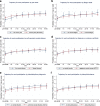Biopsychosocial predictors and trajectories of work participation after transdiagnostic occupational rehabilitation of participants with mental and somatic disorders: a cohort study
- PMID: 30111291
- PMCID: PMC6094579
- DOI: 10.1186/s12889-018-5803-0
Biopsychosocial predictors and trajectories of work participation after transdiagnostic occupational rehabilitation of participants with mental and somatic disorders: a cohort study
Abstract
Background: Group-based transdiagnostic occupational rehabilitation programs including participants with mental and somatic disorders have emerged in clinical practice. Knowledge is sparse on subsequent participation in competitive work. This study aimed to investigate trajectories for (re)entry to work for predefined subgroups in a diagnostically heterogeneous sample of sick-listed participants after completing occupational rehabilitation.
Methods: A cohort of 212 participants aged 18-69 on long-term sick leave (> 8 weeks) with chronic pain, chronic fatigue and/or common mental disorders was followed for one year after completing a 3½-week rehabilitation intervention based on Acceptance and Commitment Therapy. Self-reported, clinical and registry data were used to study the associations between predefined biopsychosocial predictors and trajectories for (re)entry to competitive work (≥ 1 day per week on average over 8 weeks). Generalized estimating equations analysis was used to investigate trajectories.
Results: For all biopsychosocial subgroups (re)entry to work increased over time. Baseline employment, partial sick leave and higher expectation of return to work (RTW) predicted higher probability of having (re)entered work at any given time after discharge. The odds of increasing reentry over time (statistical interaction with time) was weaker for the group receiving the benefit work assessment allowance compared with those receiving sickness benefit (OR = 0.92, p = 0.048) or for those on partial sick leave compared with full sick leave (OR 0.77, p < 0.001), but higher for those who at baseline had reported having a poor economy versus not (OR 1.16, p = 0.010) or reduced emotional functioning compared with not (OR 1.11, p = 0.012). Health factors did not differentiate substantially between trajectories.
Conclusions: Work participation after completing a transdiagnostic occupational rehabilitation intervention was investigated. Individual and system factors related to work differentiated trajectories for (re)entry to work, while individual health factors did not. Having a mental disorder did not indicate a worse prognosis for (re)entry to work following the intervention. Future trials within occupational rehabilitation are recommended to pivot their focus to work-related factors, and to lesser extent target diagnostic group.
Keywords: Acceptance and commitment therapy; Chronic pain; Comorbidity; Fatigue; Mental disorders; Musculoskeletal diseases; Prognosis; Return to work; Unemployment; Vocational rehabilitation.
Conflict of interest statement
Ethics approval and consent to participate
All procedures performed in the study involving human participants were in accordance with the ethical standards of the national research committee and with the 1964 Helsinki declaration and its later amendments or comparable ethical standards. Written informed consent was obtained from all individual participants included in the study. The study has been approved by the Regional Committee for Medical and Health Research Ethics in Central Norway (No.: 2010/2404).
Consent for publication
Not applicable.
Competing interests
The authors declare that they have no competing interests.
Publisher’s Note
Springer Nature remains neutral with regard to jurisdictional claims in published maps and institutional affiliations.
Figures





Similar articles
-
Randomized Controlled Trial of Adding Telephone Follow-Up to an Occupational Rehabilitation Program to Increase Work Participation.J Occup Rehabil. 2018 Jun;28(2):265-278. doi: 10.1007/s10926-017-9711-4. J Occup Rehabil. 2018. PMID: 28597308 Free PMC article. Clinical Trial.
-
Work participation after receiving multidisciplinary treatment or acceptance and commitment therapy intervention for return to work: long-term follow-up of a randomized controlled trial among sick-listed individuals with mental disorders and/or chronic pain.BMC Public Health. 2024 Dec 21;24(1):3558. doi: 10.1186/s12889-024-21116-1. BMC Public Health. 2024. PMID: 39709368 Free PMC article. Clinical Trial.
-
Multidisciplinary Intervention and Acceptance and Commitment Therapy for Return-to-Work and Increased Employability among Patients with Mental Illness and/or Chronic Pain: A Randomized Controlled Trial.Int J Environ Res Public Health. 2018 Oct 31;15(11):2424. doi: 10.3390/ijerph15112424. Int J Environ Res Public Health. 2018. PMID: 30384498 Free PMC article. Clinical Trial.
-
[Work-Related Medical Rehabilitation].Rehabilitation (Stuttg). 2017 Feb;56(1):14-21. doi: 10.1055/s-0042-118579. Epub 2017 Feb 20. Rehabilitation (Stuttg). 2017. PMID: 28219096 Review. German.
-
Effects of work-directed interventions on return-to-work in people on sick-leave for to common mental disorders-a systematic review.Int Arch Occup Environ Health. 2024 Aug;97(6):597-619. doi: 10.1007/s00420-024-02068-w. Epub 2024 May 6. Int Arch Occup Environ Health. 2024. PMID: 38710801 Free PMC article.
Cited by
-
Sick leave before and after arthroscopic partial meniscectomy due to traumatic meniscal tear.Osteoarthr Cartil Open. 2020 Feb 14;2(2):100040. doi: 10.1016/j.ocarto.2020.100040. eCollection 2020 Jun. Osteoarthr Cartil Open. 2020. PMID: 36474582 Free PMC article.
-
A scoping review to ascertain the parameters for an evidence synthesis of psychological interventions to improve work and wellbeing outcomes among employees with chronic pain.Health Psychol Behav Med. 2021 Jan 28;9(1):25-47. doi: 10.1080/21642850.2020.1863809. Health Psychol Behav Med. 2021. PMID: 34104548 Free PMC article.
-
The role of contextual factors on participation in the life area of work and employment after rehabilitation: A qualitative study on the views of persons with chronic pain.Work. 2022;71(1):119-132. doi: 10.3233/WOR-205173. Work. 2022. PMID: 34924419 Free PMC article.
-
How People with Multimorbidity and Psychosocial Difficulties Experience Support by Rehabilitation Coordinators During Sickness Absence.J Multidiscip Healthc. 2021 May 31;14:1245-1257. doi: 10.2147/JMDH.S308840. eCollection 2021. J Multidiscip Healthc. 2021. PMID: 34103925 Free PMC article.
-
The Impact of Musculoskeletal Injuries Sustained in Road Traffic Crashes on Work-Related Outcomes: A Systematic Review.Int J Environ Res Public Health. 2021 Nov 1;18(21):11504. doi: 10.3390/ijerph182111504. Int J Environ Res Public Health. 2021. PMID: 34770019 Free PMC article.
References
-
- Nieuwenhuijsen K, Faber B, Verbeek JH, Neumeyer-Gromen A, Hees HL, Verhoeven AC, et al. Interventions to improve return to work in depressed people. Cochrane Database Syst Rev. 2014;2014(12):Cd006237. - PubMed
-
- Schultz IZ. Determining disability: new advances in conceptualization and research. Springer; 2009.
Publication types
MeSH terms
LinkOut - more resources
Full Text Sources
Other Literature Sources
Medical

